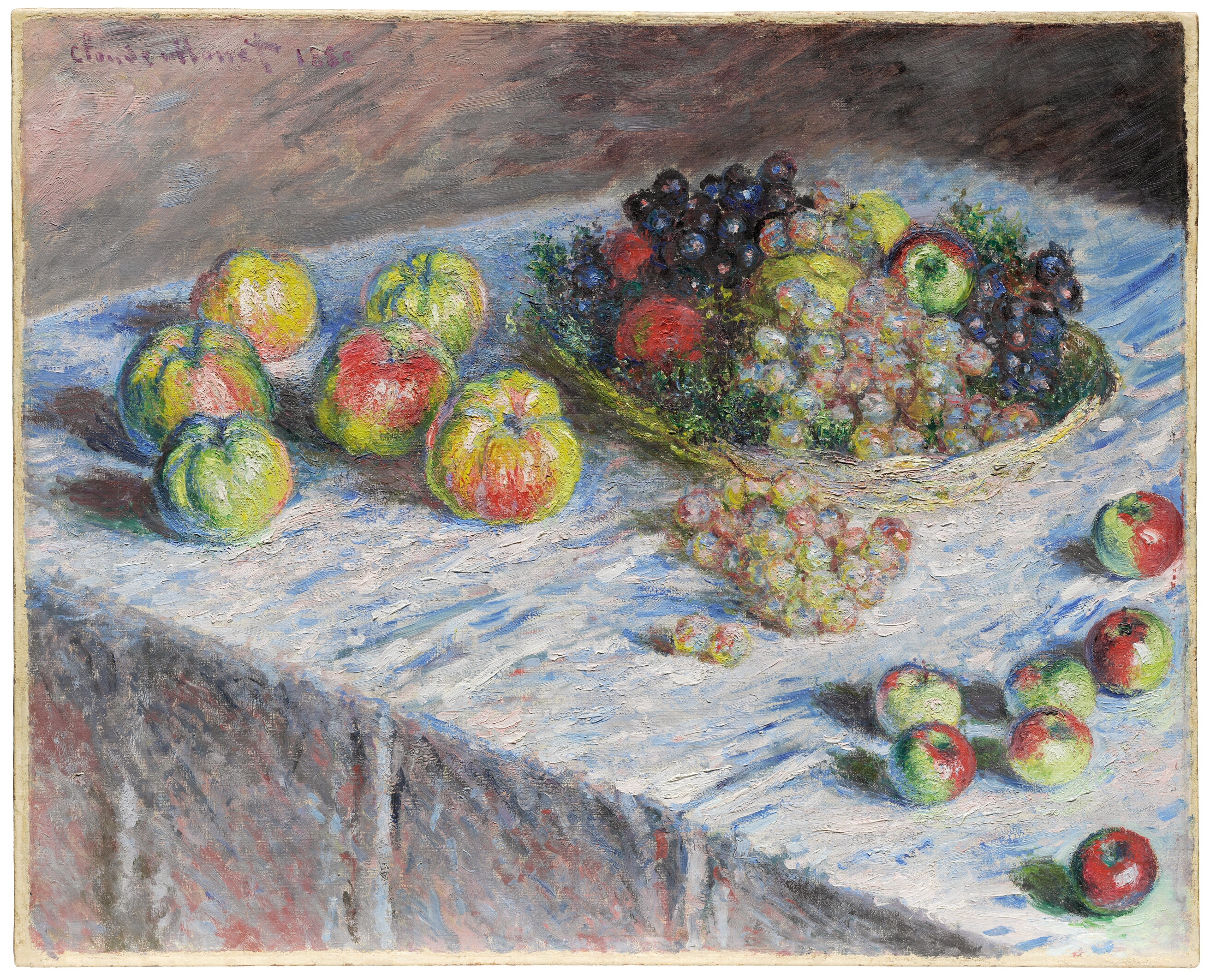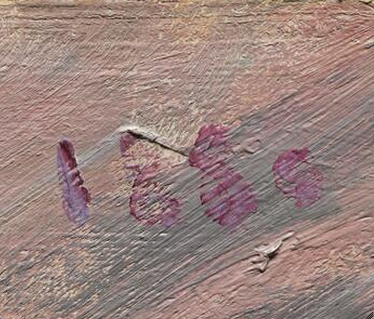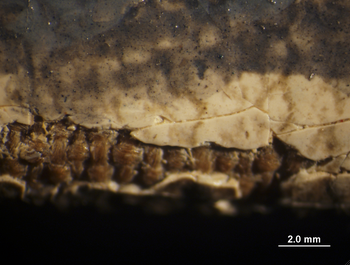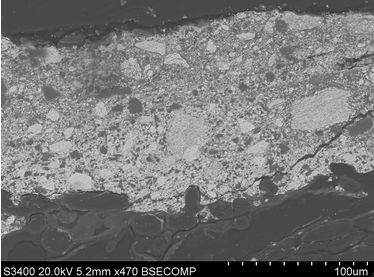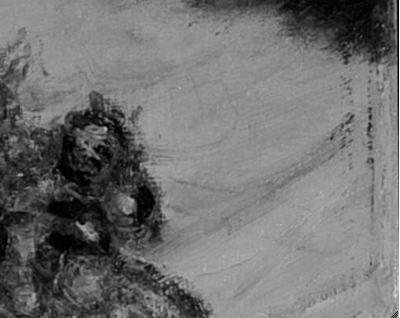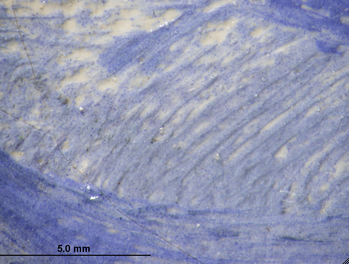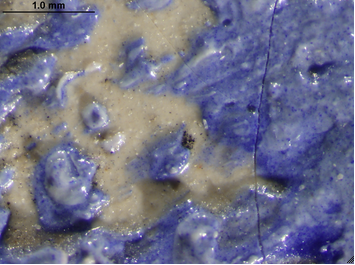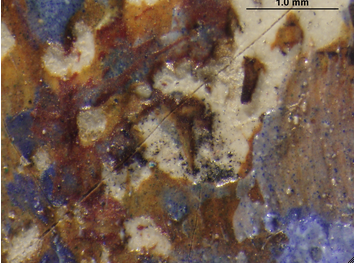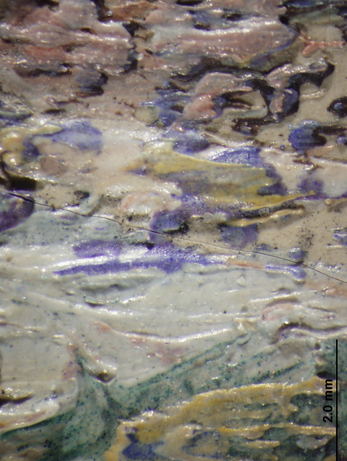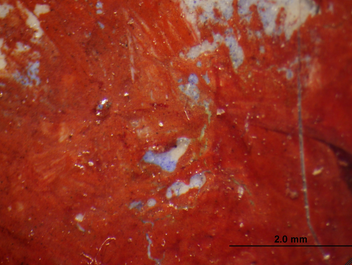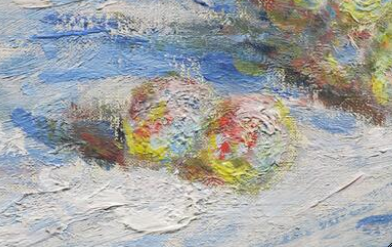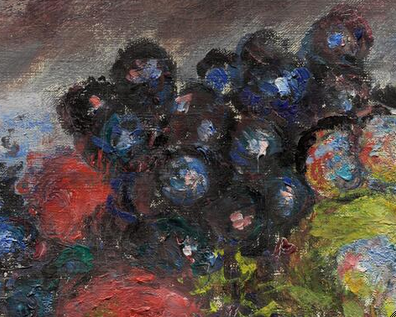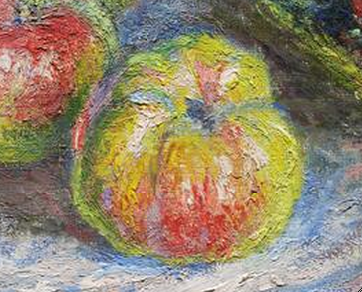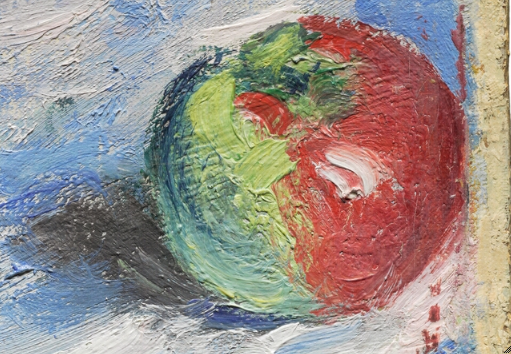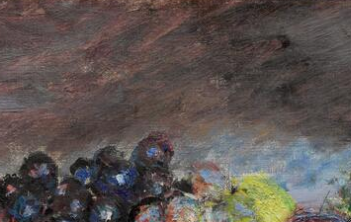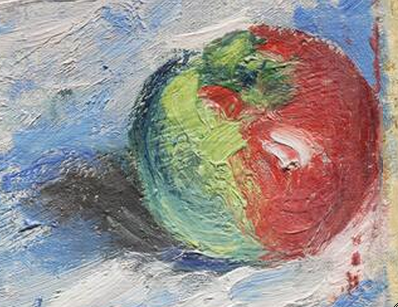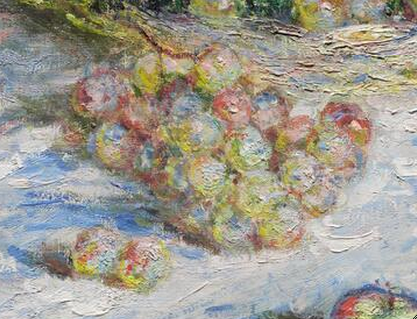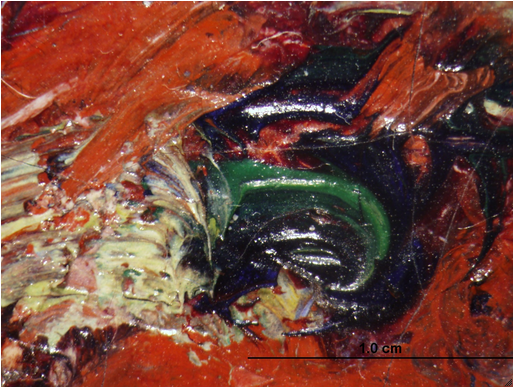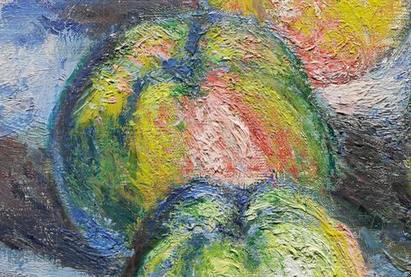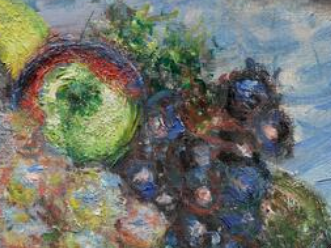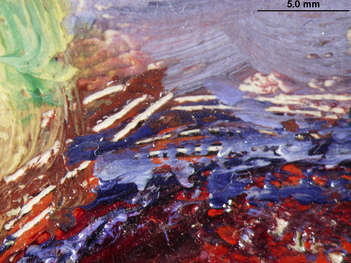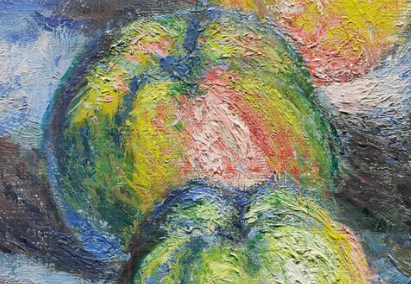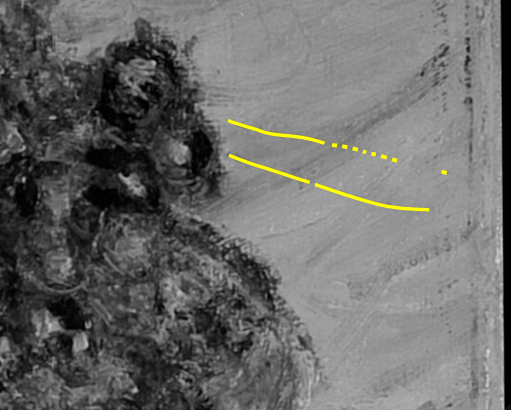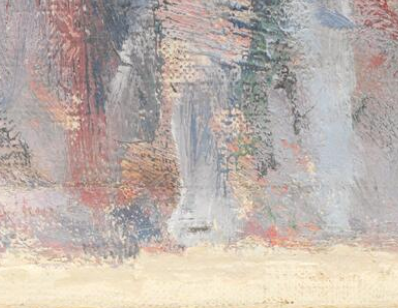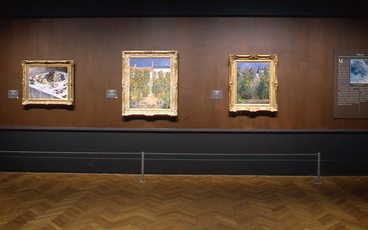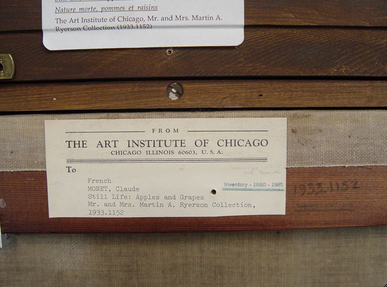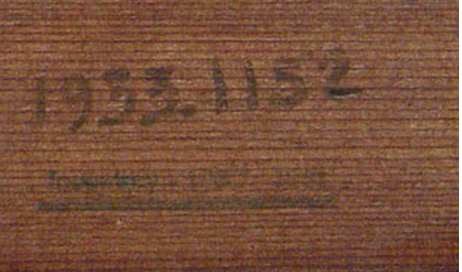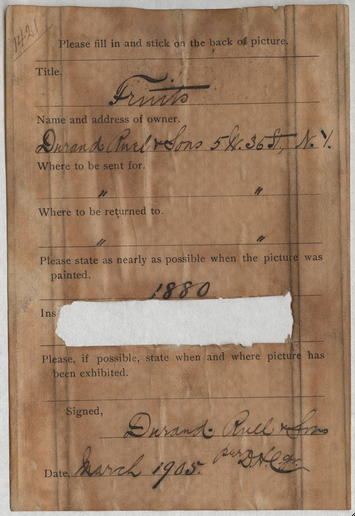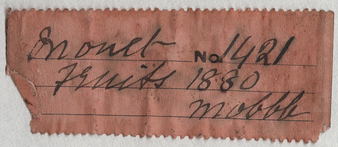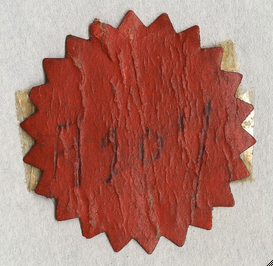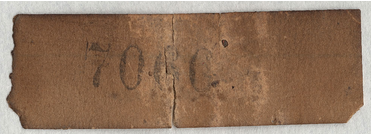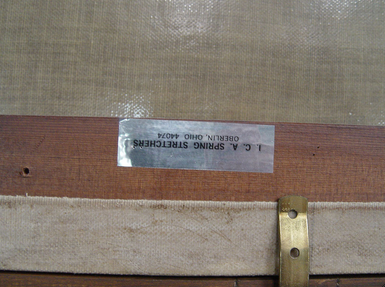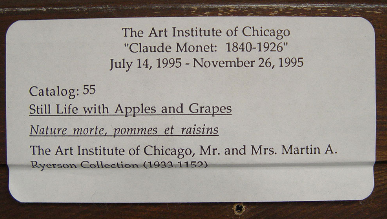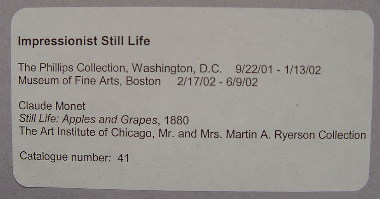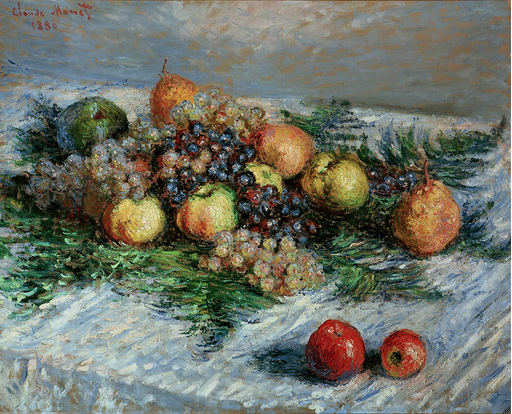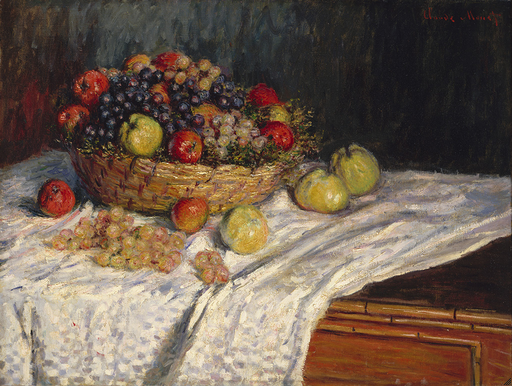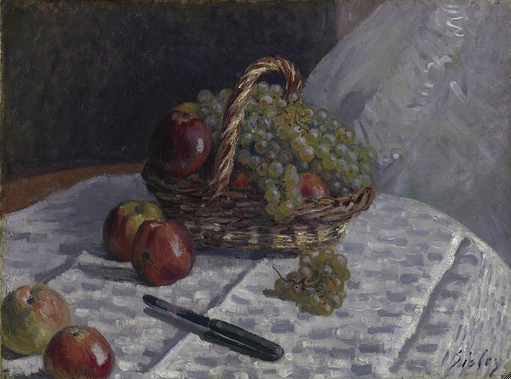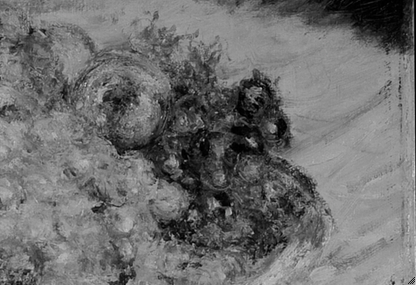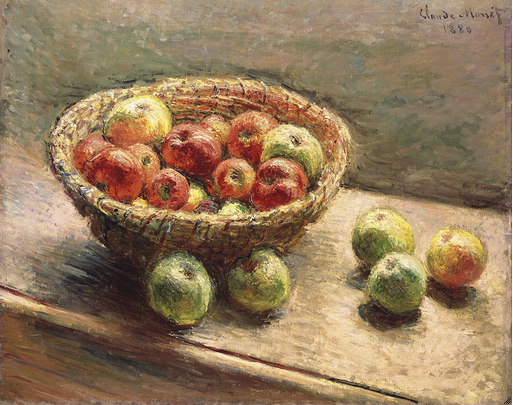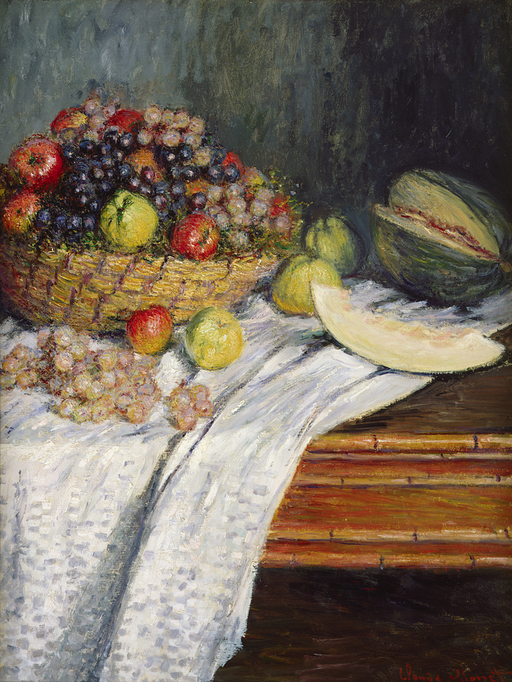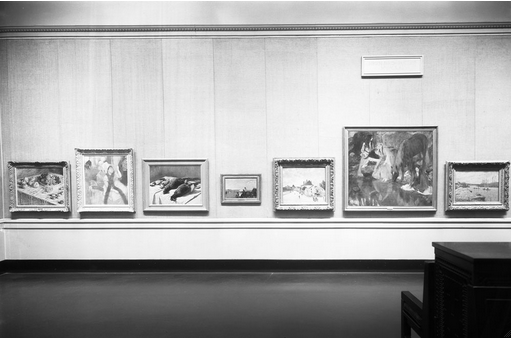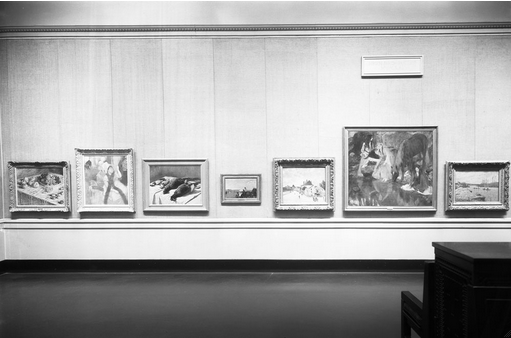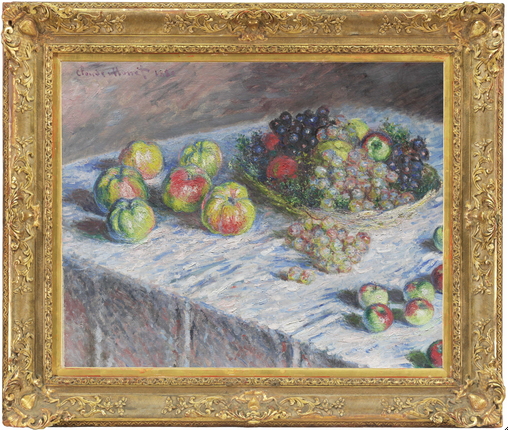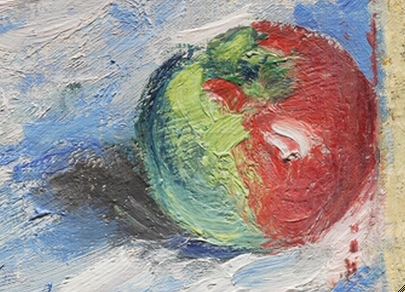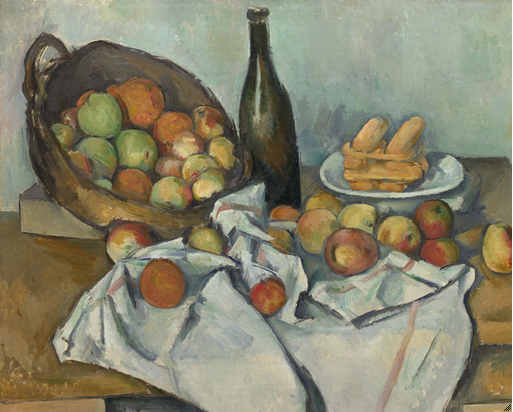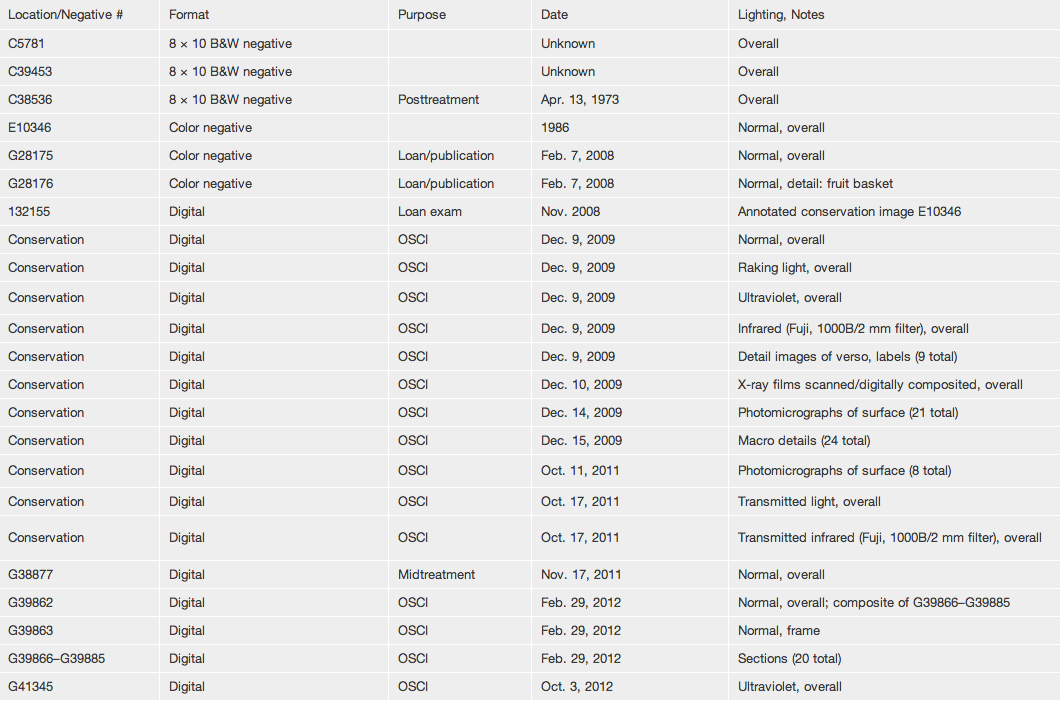Cat. 17
Apples and Grapes
1880
Oil on canvas; 66.2 × 82.3 cm (26 1/16 × 32 3/8 in.)
Signed and dated: Claude Monet 1880 (upper left, in reddish-purple paint)
The Art Institute of Chicago, Mr. and Mrs. Martin A. Ryerson Collection, 1933.1152
Monet and Still-Life Painting
In late November 1879, young Marthe Hoschedé, the future stepdaughter of Claude Monet, mentioned that the artist was making progress on a “painting of fruits” and noted that he was “working hard at his still lifes, which are very pretty.” Monet had several reasons for returning to still-life painting in 1879–80. The twenty-nine works he showed at the fourth Impressionist exhibition in 1879, mostly of Vétheuil, a suburb northwest of Paris, had received overall negative reviews, and he may have wanted to engage with a subject that was less fraught, more accessible, and more commercially viable. He was also mourning his wife, Camille, who had died on September 5, 1879, in Vétheuil, where the Monets lived with the family of the artist’s patron, Ernest Hoschedé, who had declared bankruptcy and moved abroad. Monet’s interlude with still-life painting, which occurred in the months following Camille’s death, allowed him to disassociate himself temporarily from working out of doors, which had been an integral part of his life during his years with her. With the added financial responsibilities the artist faced as the breadwinner for his two sons, as well as for the Hoschedés, painting nature mortes, in which Monet could control the subjects, light, and atmosphere, and which proved surprisingly lucrative, was probably as appealing as it was necessary.
Style and Meaning
The Art Institute’s Apples and Grapes is one of a group of related compositions of comparable scale that Monet produced in 1879–80. The Art Institute picture, along with Pears and Grapes (fig. 17.1 [W631]) in the Kunsthalle, Hamburg, and Basket of Apples (fig. 17.2 [W630]), are signed and dated 1880. The date, in addition to the increasingly radical cropping and surface treatment of the works, likely make them the last in the group. Among those thought to be executed earlier, in 1879, are the horizontal Apples and Grapes (fig. 17.3 [W545]), and the vertical Still Life with a Honeydew Melon (fig. 17.4 [W544]), both of which depict a basket overflowing with apples and grapes on a tabletop that is set at an angle and partially covered with a tablecloth. Both these and the Art Institute’s painting bear close similarity to a still life by Monet’s friend the artist Alfred Sisley, Apples and Grapes in a Basket at the Sterling and Francine Clark Art Institute (fig. 17.5). Sisley’s still life is signed but not dated, so it is difficult to know exactly the link between the two artists’ chosen subjects. Indeed, Sisley’s still life, with its exaggeratedly tilted tabletop and patterned cloth, may be a nod to Monet’s treatments of the subject, especially in the case of the Chicago picture. The success Monet had with his still-life compositions of 1879–80—which, upon completion, were exhibited and quickly sold—may also have been influential to Sisley.
The Art Institute’s still life presents a radical variation on the tabletop still-life theme. The cloth, which covers the entirety of the slanting table, pitched forward, is noticeably similar to that in the Hamburg Pears and Grapes (fig. 17.1); the table in both works fills more than three-fourths of the space, thus eliminating any sense of interior setting or surroundings. In the Hamburg version, Monet omits the basket, resting the fruit instead on a blanket of evergreen branches, which, combined with the addition of walnuts, may refer to the season in which the work was completed. The long, sweeping, blue-and-white brushstrokes used to define the cloth in the Hamburg picture are also seen in the Chicago still life, in which the cloth is in dramatic contrast to the darker background. Moreover, [glossary:infrared reflectography] of the Chicago painting reveals two diagonal lines on the right side of the basket (fig. 17.6), suggesting that at an early state in the composition, Monet may have drawn the table edge closer in so that the basket would be farther back on the table, echoing its placement in the Metropolitan Museum and Hamburger Kunsthalle versions (fig. 17.3 and fig. 17.5).
The Chicago version displays both bold compositional organization as well as complex painterly technique. The grapes and apples are especially built up, and their varieties are indicated not only by color and shape but also by the way the paint is handled. The larger apples in particular are made up of textural daubs and strokes of low-to-medium impasto; Monet seems to have pushed further the idea of building up their density and separating them out. Not only did he make use of strong outlining strokes—for example, the deep-blue stroke used to indicate the edge of the fruit in shadow (fig. 17.7)—he also incised outlines using a fine-pointed instrument. For the topmost red-and-green apple at right in the basket, Monet scraped into the paint, so that the apple’s contours are defined not only by the circle of pigment but also by the cream-colored ground layer that shows through (fig. 17.8 and fig. 17.9; see Technical Report). A similar technique, whereby heavy outlines of impastoed shapes are carved with a pointed instrument, is seen also in Paul Cézanne’s The Plate of Apples (fig. 17.10). Both artists manifested a related approach to their subjects, evident in the tilt of the tabletop; its indeterminate spatial relationship to the wall; the balance between firmly anchored forms (the larger green cooking apples in Monet’s work, for example) and smaller, more randomly placed ones (such as other apples in Monet’s composition that seem ready to roll off the table at lower right); and the emphasis on contour, whether in pigment or in its excision.
Exhibition at La Vie Moderne
After the initial [glossary:wet-on-wet] [glossary:lay-in] of compositional elements, such as the tablecloth and fruit, Monet later added wet-on-dry touches. This suggests that he returned to this painting to build up highlights and add the uppermost apple on the right side, which [glossary:X-ray] imaging confirms was painted on top of the tablecloth (fig. 17.11), and the signature. The evidence of paint applied over an already-dry layer may indicate that the work was begun earlier, during the autumn of 1879 when he had supplies on hand. If so, then the canvas may have been picked up again in April 1880 when Monet was preparing for a June one-man exhibition at the offices of La Vie Moderne. For Monet, who was hoping to expand his market after yet another Salon jury rejection, the exhibition was a godsend and, as some scholars have argued, a critical turning point in his career.
The Art Institute painting is thought to correspond to what the exhibition’s catalogue lists as “Corbeille de fruits,” one of two still lifes (the other listed as “Gibier” [possibly W551]), in a well-received exhibition. Several paintings were purchased, including Floating Ice (1880; Shelburne (Vt.) Museum [W568]), which the Salon jury had refused a few months earlier. The owners were not listed in the catalogue, but Apples and Grapes was likely lent by the artist to the show and possibly sold soon after, along with two other works, to a collector known only as Cahuzac.
Although the June exhibition took place in an elegant shopping district on the fashionable boulevard des Italiens, with the approval of his patron-friends, Monet took particular care with his self-presentation. The interview he crafted with Émile Tabareux, as well as the introduction written by Théodore Duret for the catalogue, emphasized Monet’s work en plein air and his mission to capture the sensation of nature. As examples of this view of his art, Monet included “Corbeille de fruits,” which has been tentatively identified as the Chicago painting, the most technically and compositionally daring of the 1879–80 output.
Monet painted still lifes throughout his life, yet the fruit compositions from 1879–80 represent his most concentrated effort in the genre. It was also the last time he would pair apples and grapes, the bounty of the local harvest. Perhaps, as the art historian John House has posited, Monet’s decision to rework and retouch canvases in the studio occupied his indoor activity to the extent that, instead of setting up still lifes to paint when forced indoors, he was using his studio time to advance works already in progress.
Gloria Groom
Technical Report
Technical Summary
Claude Monet’s Apples and Grapes was painted on a [glossary:pre-primed], no. 25 portrait ([glossary:figure]) standard-size linen [glossary:canvas]. The cream-colored [glossary:ground] consists of two layers. A [glossary:warp-thread match] was determined with Monet’s Cliff Walk at Pourville ( (cat. 19 [W758]), suggesting that the fabric for these paintings came from the same [glossary:bolt] of material. Traces of charcoal [glossary:underdrawing] were observed at the edges of the table, the basket, and some of the fruit. In the process of painting, the artist appears to have changed the position of the back right edge of the table. Much of the foreground consists of rich, brush-marked [glossary:impasto], especially the apples and grapes, which are often composed of a complex buildup of multicolored strokes. In contrast, the background, especially on the right side of the painting, contains washes of thinned reddish-brown paint. One of the apples on the right side was a late addition to the painting.
Multilayer Interactive Image Viewer
The multilayer interactive image viewer is designed to facilitate the viewer’s exploration and comparison of the technical images (fig. 17.12).
Signature
Signed and dated: Claude Monet 1880 (upper left, in reddish-purple paint) (fig. 17.13). The signature and date were applied when the underlying paint layers were already dry (fig. 17.14).
Structure and Technique
Support
Canvas
Flax (commonly known as linen).
Standard format
The original dimensions were approximately 65 × 81 cm. This corresponds to a no. 25 portrait (figure) standard-size canvas, turned horizontally.
Weave
[glossary:Plain weave]. Average [glossary:thread count] (standard deviation): 19.3V (0.4) × 19.9H (0.7) threads/cm; the vertical threads were determined to correspond to the [glossary:warp] and the horizontal threads to the [glossary:weft]. A warp-thread match with Monet’s Cliff Walk at Pourville (1882; 1933.443 [W758]) (cat. 19) was determined.
Canvas characteristics
There is mild, relatively even [glossary:cusping] around all four edges.
Stretching
Current stretching: Dates to 1973 treatment (see Conservation History); copper tacks spaced 5–10 cm apart.
Original stretching: Tack holes, spaced approximately 5–7 cm apart, correspond to cusping in the canvas (fig. 17.15). Additional holes are probably related to subsequent tacks used to reinforce attachment where the original tacks holes were deteriorated.
Stretcher/strainer
Current stretcher: Four-membered [glossary:ICA spring stretcher]; dates to 1973 [glossary:lining] (see Conservation History).
Original stretcher: The pre-1973-treatment [glossary:stretcher] may have been the original stretcher. In an undated report, it is described as five-membered with a vertical [glossary:crossbar], mitered corners, [glossary:mortise and tenon joints], ten [glossary:keys], and beveled front and back. The report gives the following stretcher dimensions: overall, 65 × 81 cm; outside depth, 0.8 cm; width, 6 cm; inside depth, 0.8 cm; and distance from canvas position, 0.2 cm.
Manufacturer’s/supplier’s marks
The pre-1973-treatment stretcher (discarded) had a stamp on the vertical crossbar: 25w [encircled]. (fig. 17.16)
Preparatory Layers
Sizing
Not determined (probably glue).
Ground application/texture
The ground extends to the edges of all four [glossary:tacking margins], indicating that the canvas was cut from a larger piece of primed fabric, which was probably commercially prepared. The ground ranges from approximately 100 to 150 µm in thickness (fig. 17.17). Cross-sectional examination indicates that the ground consists of a double application. The backscattered electron ([glossary:BSE]) image shows the lower region to be slightly more compact and richer in lead white, as evidenced by its brighter white appearance (fig. 17.18). Particles and clusters of lead white and chalk are present in a wide range of sizes.
Color
The ground is a warm cream tone (fig. 17.19).
Materials/composition
Analysis indicates that both layers contain primarily lead white and calcium carbonate (chalk), with traces of iron oxide yellow, silicate minerals, alumina, and silica; microscopically, a few black and reddish-brown pigment particles were observed.
Compositional Planning/Underdrawing/Painted Sketch
Extent/character
[glossary:Infrared reflectography] (IRR) detected two, roughly parallel, drawn lines extending from the upper right grapes in the basket at a slight angle down to the right edge of the painting (fig. 17.20). Microscopic examination further revealed the presence of black particles sparsely dispersed in this area (fig. 17.21) and intermittently around the front and back left table edges (fig. 17.22), the grapes on the table (fig. 17.23), and the basket (fig. 17.24). The underdrawing material is present only as traces where observed.
Medium/technique
Charcoal.
Revisions
The two parallel lines at the upper right edge do not correlate with forms in the final composition but are likely related to the back edge of the table, which was pushed further back in the painting stage. The other areas of underdrawing seem to correspond closely with the edges of the forms as painted.
Paint Layer
Application/technique and artist’s revisions
The paint application is mostly [glossary:wet-on-wet], with only some of the final touches applied over set-up paint. The composition was built up as a whole, with the basket and fruit incorporated into the picture from early on; these elements all appear to be painted directly over the ground with the tablecloth built up around them. The only exception to this is the uppermost apple on the right side. The [glossary:X-ray] shows that this apple was painted on top of the tablecloth and, therefore, was a later addition to the composition (fig. 17.25). Blue paint from the tablecloth is visible in small areas through breaks in the red paint of this apple, which appears to have been applied when the tablecloth was already dry (fig. 17.26).
The cream-colored ground layer remains exposed at breaks in the brushwork throughout the composition, often at the junctures of forms (fig. 17.27). Around the dark-purple grapes, for example, the ground can be seen in areas where the brush has been dragged lightly across the surface (fig. 17.28). This serves to break up the solidity of the forms, to create space between individual grapes, and to give a sense of their three-dimensionality. The paint application ranges from relatively flat, opaque brushstrokes to textural daubs and strokes of low-to-medium impasto, which occur especially in the lead white–rich passages, such as the light areas of the tablecloth and the highlights of the fruit (fig. 17.29). The background is rather thinly and sketchily painted, particularly the dark reddish-brown area on the right side, which is applied in thin washes of color (fig. 17.30). In general, there is very little blending or mixing of colors on the canvas, only some incidental mixing resulting from the wet-on-wet paint application (fig. 17.31). Rather, the brushwork consists of discrete strokes and touches of color that are juxtaposed and superimposed in rather complex buildups (fig. 17.32). For example, upon closer examination, one can see that the dark, shadowed stem region of one of the apples at lower right actually consists of short, superimposed touches of bright green over deep blue and red (fig. 17.33). The light-colored grapes on the table are constructed from multiple touches using a rather large variety of paint colors (fig. 17.34). The paint application is thicker in the center of each grape, with exposed ground or lightly dragged paint visible around the edges. Many of the apples have a relatively rough surface texture caused by the layering of strokes and especially by the low peaks of paint created when the brush, loaded with relatively stiff paint, was pressed onto and then pulled away from the surface (fig. 17.35). At the upper border of the red and green apple on the right side in the basket, the artist has scraped into the paint with a fine-pointed instrument to expose the cream-colored ground layer (fig. 17.36, fig. 17.37). This appears to have been done before the adjacent blue and yellow paints were applied. The artist often makes use of strong outlining strokes, for example, the deep blue used to suggest the edge of the fruit passing into shadow (fig. 17.38) or, in the case of the dark-purple grapes in the right side of the basket, a contrasting bright orange-red that helps to delineate some of the individual forms.
Based on the presence of two charcoal lines running parallel to the back right edge of the table (as mentioned above; see Underdrawing), it seems that the artist changed his mind about the position of this edge (fig. 17.39). The edge would originally have been closer to the basket, about 6 cm lower than its current position. The change was made early in the painting process, as the brown background is painted only to the current edge of the table and does not continue underneath it. A horizontal impression made in the paint when it was still soft is visible intermittently along the bottom edge, about 1 cm inside of the original [glossary:foldover]. This could be related to a frame rebate or to some type of transport method used before the painting was completely dry (fig. 17.40). There are smears of red paint at the right edge, in the area of the apple that was added later to the composition (fig. 17.41). Again, this may be related to framing or transport when the paint from the apple was still wet. Some traces of anomalous paint are also visible along the left edge.
Painting tools
Brushes, including 0.5 and 1.0 cm width, flat ferrule (based on width and shape of brushstrokes).
Palette
Analysis indicates the presence of the following [glossary:pigments]: lead white, cobalt blue, ultramarine blue, emerald green, viridian, vermilion, red lake, cadmium yellow, chrome yellow, and bone black. Different [glossary:UV fluorescence] characteristics were observed both macroscopically and microscopically, suggesting that more than one red lake was used. Only one type was analyzed by surface-enhanced Raman spectroscopy ([glossary:SERS]) and identified as carmine lake. Chalk particles in the form of coccoliths were found associated with the carmine lake particles. Aluminum and phosphorus were detected in association with other red lake particles, thus supporting the hypothesis that two different red [glossary:lake pigments] were used.
Binding media
Oil (estimated).
Surface Finish
Varnish layer/media
The painting is currently unvarnished. In 1973, a yellowed [glossary:varnish] was removed and replaced with [glossary:synthetic varnish]. The synthetic varnish was removed in 2011 (see Conservation History). A 1957 examination report indicates that the painting was already varnished by that date.
Conservation History
In 1973, discolored surface films were removed. The painting was wax-resin lined and re-stretched on a new ICA spring stretcher. A layer of polyvinyl acetate (PVA) AYAA was applied. [glossary:Inpainting] was carried out. A layer of methacrylate resin L-46 was applied, followed by a final layer of AYAA. The pretreatment report mentions that, at an earlier date, glue may have been ironed into the back of the canvas due to the presence of slightly crushed impasto.
In 2011–12, the synthetic varnish applied in 1973 was removed, and the painting was left unvarnished. Losses at the edges were filled. Minor [glossary:retouching] was limited to the edges and some of the wider cracks in the compositional area.
Condition Summary
The painting is in good condition. It is wax-resin lined and stretched taut and in plane on an ICA spring stretcher. The paint layer is in good condition, with only tiny losses of paint and ground at the original foldovers. Several of these tiny flakes of ground and paint became adhered to the paint surface during lining. There is minor retouching around the edges and in some of the wider-aperture [glossary:drying cracks] within the composition. Remnants of older retouching observed microscopically throughout the paint surface suggest that the work was broadly retouched in a previous treatment. This seems to have included retouching some original areas of exposed ground. There is an overall network of light [glossary:craquelure], as well as localized drying cracks that occur mainly in the deep reds and in the more translucent, medium-rich areas. There are starch-paste residues from the 1973 facing visible microscopically over the surface. The painting is currently unvarnished.
Kimberely Muir
Frame
The current frame appears to be original to the painting. It is a French (Parisian), late nineteenth-century, Durand-Ruel, Régence Revival, ogee frame with cast foliate center and corner cartouches and an independent liner. The frame has both water and oil gilding over bole on cast plaster and gesso. Two different shades of gold were used: one alloy on the outer frame and another on the liner. The bole color is also varied. Red bole was used on the perimeter molding, the cast foliate on the ogee and sight molding, the scotia sides, and the liner. Red-orange bole was used on the sanded frieze and bordering fillets. The ornament and sight molding are selectively burnished. The liner was burnished; at a later date, the gilding was scraped off the sight edge. The frame has an overall bronze tone, with casein or gouache raw umber and gray washes. The frame has a glued pine substrate with a cast plaster face. At a later date the original back of the frame was planed flat, removing all construction history and provenance. A back frame was then glued to the back. All back and interior surfaces have been overpainted. The molding, from perimeter to interior, is fillet with cast, stylized, running undulating bands with rhomboid center punches; scotia side; ogee face with a cast crosshatched bed and center and corner foliate and floral cartouches with cabochon centers on a double-lined diamond bed with punched centers; fillet; sanded front frieze; fillet; ogee with stylized leaf-tip-and-shell sight molding; and an independent fillet liner with a cove sight (fig. 17.42, fig. 17.43).
Kirk Vuillemot
Provenance
Possibly sold by the artist to Cahuzac, Paris, Nov. 1880, in addition to two other paintings (Fleurs, pommes; and Les Saules), for 1,000 francs.
Possibly acquired by Durand-Ruel, Paris, c. 1883.
Acquired by Catholina Lambert, Paterson, N.J., by May 16, 1895.
Sold by Catholina Lambert, Paterson, New Jersey, to Durand-Ruel, New York, May 16, 1895.
Sold by Durand-Ruel, New York, to Martin A. Ryerson, Chicago, Dec. 18, 1915, for $8,100.
Bequeathed by Martin A. Ryerson, Chicago (died 1932), to the Art Institute of Chicago, 1933.
Exhibition History
Possibly Paris, office of La Vie Moderne, Le peintre Claude Monet, June 1880, cat. 2, as Corbeille de fruits.
New York, Durand-Ruel Galleries, Exhibition of Paintings by Claude Monet, Feb. 11–25, 1902, cat. 8, as Fruits.
Boston, Copley Society, Loan Collection of Paintings by Claude Monet and Eleven Sculptures by Auguste Rodin, Mar. 1905, cat. 2, as Fruits. 1880, Lent by Messrs. Durand–Ruel & Sons.
New York, Durand-Ruel Galleries, Exhibition of Paintings by Claude Monet, Jan. 26–Feb. 14, 1907, cat. 17, as Fruits, 1880.
Possibly Berlin, Paul Cassirer, XI. Jahrgang, II. Ausstellung: Kollektion Lovis Corinth, Ausstellung ‘Stilleben,’ Oct. 15–Nov. 8, 1908, cat. 51, as Stilleben, Früchte.
Washington, D.C., Corcoran Gallery of Art, Special Exhibition of Paintings by the Masters of the Modern French School, Feb. 11–Mar. 5, 1911, cat. 21, as Fruits, 1880.
New York, Durand-Ruel Galleries, Exhibition of Paintings Representing Still Life and Flowers by Manet, Monet, Pissarro, Renoir, Sisley, André d’Espagnat, Dec. 20, 1913–Jan. 8, 1914, cat. 6, as Fruits.
Chicago, Auditorium Hotel, [Tableaux Durand-Ruel], Dec. 1915.
University of Chicago, Feb. 11–23, 1918.
Art Institute of Chicago, “A Century of Progress”: Loan Exhibition of Paintings and Sculpture, May 23–Nov. 1, 1933, cat. 297. (fig. 17.44)
Art Institute of Chicago, “A Century of Progress”: Loan Exhibition of Paintings and Sculpture for 1934, June 1–Oct. 31, 1934, cat. 217.
Art Gallery of Toronto, An Exhibition of Great Paintings in the Aid of the Canadian Red Cross, Nov. 15–Dec. 15, 1940, cat. 102.
Art Institute of Chicago, The Paintings of Claude Monet, Apr. 1–June 15, 1957, no cat. no.
City Art Museum of St. Louis, Claude Monet: A Loan Exhibition, Sept. 25–Oct. 22, 1957, cat. 44 (ill.); Minneapolis Institute of Arts, Nov. 1–Dec.1, 1957.
Art Institute of Chicago, Paintings by Monet, Mar. 15–May 11, 1975, cat. 46 (ill.). (fig. 17.45)
Albi, Musée Toulouse-Lautrec, Trésors impressionnistes du Musée de Chicago, June 27–Aug. 31, 1980, cat. 11 (ill.).
Tokyo, Seibu Museum of Art, Shikago bijutsukan insho-ha ten [The Impressionist tradition: Masterpieces from the Art Institute of Chicago], Oct. 18–Dec. 17, 1985, cat. 39 (ill.); Fukuoka Art Museum, Jan. 5–Feb. 2, 1986; Kyoto Municipal Museum of Art, Mar. 4–Apr. 13, 1986.
Art Institute of Chicago, Claude Monet, 1840–1926, July 22–Nov. 26, 1995, cat. 55 (ill.). (fig. 17.46)
Washington, D.C., Phillips Collection, Impressionist Still Life, Sept. 22, 2001–Jan. 13, 2002, cat. 41 (ill.); Boston, Museum of Fine Arts, Feb. 17–June 9, 2002.
Fort Worth, Tex., Kimbell Art Museum, The Impressionists: Master Paintings from the Art Institute of Chicago, June 29–Nov. 2, 2008, cat. 33 (ill.).
Selected References
Possibly Théodore Duret, Le peintre Claude Monet, exh. cat. (G. Charpentier, 1880), p. 14, cat. 2.
Possibly “Notre exposition, Claude Monet,” La vie moderne, June 19, 1880, p. 400.
Durand-Ruel Galleries, New York, Exhibition of Paintings by Claude Monet, exh. cat. (Durand-Ruel, 1902), cat. 8.
Copley Society, Loan Collection of Paintings by Claude Monet and Eleven Sculptures by Auguste Rodin, exh. cat. (Copley Society, 1905), p. 12, cat. 2.
Durand-Ruel Galleries, New York, Exhibition of Paintings by Claude Monet, exh. cat. (Durand-Ruel, 1907), cat. 17.
Possibly Paul Cassirer Gallery, Berlin, XI. Jahrgang, II. Ausstellung, exh. cat. (Paul Cassirer, 1908), cat. 51.
Corcoran Gallery of Art, Special Exhibition of Paintings by the Masters of the Modern French School (Corcoran Gallery of Art, 1911), cat. 21.
Durand-Ruel Galleries, New York, Exhibition of Paintings Representing Still Life and Flowers by Manet, Monet, Pissarro, Renoir, Sisley, André, d’Espagnat (Durand-Ruel, 1913), cat. 6.
Art Institute of Chicago, A Guide to the Paintings in the Permanent Collection (Art Institute of Chicago, 1925), p. 162, cat. 2141.
M. C., “Monets in the Art Institute,” Bulletin of the Art Institute of Chicago 19, 2 (Feb. 1925), p. 19 (ill.).
Anthony Bertram, Claude Monet, World’s Masters (Studio/William Edwin Rudge, 1931), pl. 24.
Art Institute of Chicago, Catalogue of “A Century of Progress”: Exhibition of Paintings and Sculpture; Lent from American Collections, ed. Daniel Catton Rich, 3rd ed., exh. cat. (Art Institute of Chicago, 1933), p. 43, cat. 297.
Daniel Catton Rich, “Französische Impressionisten im Art Institute zu Chicago,” Pantheon (Mar. 1933), p. 77. Translated by C. C. H. Drechsel as “French Impressionists in the Art Institute of Chicago,” Pantheon/Cicerone (Mar. 1933), p. 18.
Art Institute of Chicago, Catalogue of “A Century of Progress”: Exhibition of Paintings and Sculpture, 1934, ed. Daniel Catton Rich, exh. cat. (Art Institute of Chicago, 1934), p. 37, cat. 217.
George Slocombe, “Giver of Light,” Coronet (Mar. 1938), p. 19 (ill.).
“Technique of Painting—II, a Study of Impressionism,” Coronet 6, 2 (June 1939), p. 101 (ill.) and (detail).
Art Gallery of Toronto, An Exhibition of Great Paintings in the Aid of the Canadian Red Cross, exh. cat. (Art Gallery of Toronto, 1940), p. 23, cat. 102.
Charles Fabens Kelley, “Fruit: Apples and Grapes: A Painting by Claude Monet,” Christian Science Monitor, Aug. 19, 1941, (ill.).
Art Institute of Chicago, “Department of Reproductions,” Bulletin of the Art Institute of Chicago 38, 4 (Apr.–May 1944), p. 70.
Art Institute of Chicago, “Department of Reproductions,” Bulletin of the Art Institute of Chicago 38, 5 (Sept.–Oct. 1944), p. 85.
Art Institute of Chicago, An Illustrated Guide to the Collections of the Art Institute of Chicago (Art Institute of Chicago, 1948), p. 37.
Oscar Reuterswärd, Monet: En konstnärshistorik (Bonniers, 1948), p. 280.
Heinz School Service Library, “Familiar Foods in Famous Paintings,” Carnegie Magazine 24, 2 (Feb. 1950), p. 250 (ill.).
Art Institute of Chicago, “Catalogue,” Art Institute of Chicago Quarterly 51, 2 (Apr. 1, 1957), p. 33.
Art Institute of Chicago, “Chronology,” Art Institute of Chicago Quarterly 51, 2 (Apr. 1, 1957), p. 30 (ill.).
Edith Weigle, “The Wonderful World of Art,” Chicago Daily Tribune, May 26, 1957, p. E2 (ill.).
Claude Monet: A Loan Exhibition, exh. cat. (Minneapolis Society of the Fine Arts, 1957), p. 60, cat. 44 (ill.).
William C. Seitz, “Claude Monet’s View of Nature,” in Claude Monet: A Loan Exhibition, exh. cat. (Minneapolis Society of the Fine Arts, 1957), pp. 20, 27.
William C. Seitz, Claude Monet, Library of Great Painters (Abrams, 1960), pp. 30, fig. 34; 114.
Art Institute of Chicago, Paintings in the Art Institute of Chicago: A Catalogue of the Picture Collection (Art Institute of Chicago, 1961), p. 319.
Charles C. Cunningham and Satoshi Takahashi, Shikago bijutsukan [Art Institute of Chicago], Museums of the World 32 (Kodansha, 1970), pp. 58, cat. 44 (ill.); 161–62.
Daniel Wildenstein, Claude Monet: Biographie et catalogue raisonné, vol. 1, Peintures, 1840–1881 (Bibliothèque des Arts, 1974), pp. 350; 351, cat. 546 (ill.); 446, pièce justificative 37.
Susan Wise, ed., Paintings by Monet, exh. cat. (Art Institute of Chicago, 1975), p. 100, cat. 46 (ill.).
Joel Isaacson, Claude Monet, Observation and Reflection (Phaidon/Dutton, 1978), pp. 23; 110, pl. 62; 211, no. 62; 213.
Luigina Rossi Bortolatto, L’opera completa di Claude Monet: 1870–1889, Classici dell’arte 63 (Rizzoli, 1972), pp. 100; 101, cat. 186 (ill.).
Art Institute of Chicago, “New Installation of Earlier Paintings,” Bulletin of the Art Institute of Chicago 73, 1 (Jan.–Feb. 1979), p. 15.
Musée Toulouse-Lautrec and Art Institute of Chicago, Trésors impressionnistes du Musée de Chicago, exh. cat. (Musée Toulouse-Lautrec, 1980), pp. 13, no. 11 (ill.); 67.
Art Institute of Chicago, Seibu Museum of Art, Kyoto Municipal Museum of Art, and Fukuoka Art Museum, Shikago bijutsukan insho-ha ten [The Impressionist tradition: Masterpieces from the Art Institute of Chicago], exh. cat. (Nippon Television Network, 1985), pp. 86, cat. 39 (ill.); 87 (detail); 149 (ill.).
Daniel Wildenstein, Claude Monet: Biographie et catalogue raisonné, vol. 4, Peintures, 1899–1926 (Bibliothèque des Arts, 1985), pp. 31, n. 274; 44, n. 412.
Richard R. Brettell, French Impressionists (Art Institute of Chicago/Abrams, 1987), pp. 67, 68 (ill.), 118.
Daniel Wildenstein, Claude Monet: Catalogue raisonné, vol. 5, Supplément aux peintures: Dessins; Pastels; Index (Wildenstein Institute, 1991), p. 34, cat. 546.
Michael Howard, ed., The Impressionists by Themselves: A Selection of Their Paintings, Drawings and Sketches with Extracts from Their Writings (Conran Octopus, 1991), pp. 225 (ill.), 320.
Christopher Lloyd, “Still-Life: Apples and Grapes,” in Alfred Sisley, ed. Mary Anne Stevens, exh. cat. (Royal Academy of Arts, London/Musée d’Orsay/Walters Art Gallery/Yale University Press, 1992), p. 174.
Sophie Fourny-Dargère, Monet, Profils de l’art (Chêne, 1992), p. 152, fig. 7.
James Yood, Feasting: A Celebration of Food in Art: Paintings from the Art Institute of Chicago (Art Institute of Chicago/Universe, 1992), pp. 54–55, pl. 18.
Art Institute of Chicago, Treasures of 19th- and 20th-Century Painting: The Art Institute of Chicago, with an introduction by James N. Wood (Art Institute of Chicago/Abbeville, 1993), p. 80 (ill.).
Andrew Forge, Monet, Artists in Focus (Art Institute of Chicago, 1995), pp. 24–25; 27 (detail); 77, pl. 6; 106.
Charles F. Stuckey, with the assistance of Sophia Shaw, Claude Monet, 1840–1926, exh. cat. (Art Institute of Chicago/Thames & Hudson, 1995), pp. 77, cat. 55 (ill.); 206; 235; 237; 238.
Daniel Wildenstein, Monet, or The Triumph of Impressionism, cat. rais., vol. 1 (Taschen/Wildenstein Institute, 1996), pp. 147 (ill.), 149.
Daniel Wildenstein, Monet: Catalogue raisonné/Werkverzeichnis, vol. 2, Nos. 1–968 (Taschen/Wildenstein Institute, 1996), pp. 213, cat. 546 (ill.); 214.
Matthias Arnold, Claude Monet, Rowohlts Monographien (Rowohlt, 1998), p. 82 (ill.).
Meyer Schapiro, Impressionism: Reflections and Perceptions, ed. Adrienne M. Baxter (Braziller, 1997), pp. 202, fig. 100; 204.
Annette Dixon, “The Marketing of Monet: The Exhibition at La Vie Moderne,” in Annette Dixon, Carole McNamara, and Charles Stuckey, Monet at Vétheuil: The Turning Point, exh. cat. (University of Michigan, 1998), pp. 104, fig. 3; 109.
Art Institute of Chicago Impressionism and Post-Impressionism in the Art Institute of Chicago, selected by James N. Wood (Art Institute of Chicago/Hudson Hills, 2000), p. 64 (ill.).
Alexandra Ames Lawrence, “Sisley/Monet,” in Eliza E. Rathbone and George T. M. Shackelford, Impressionist Still Life, exh. cat. (Phillips Collection/Abrams, 2001), pp. 106; 109, pl. 41; 230, n. 94.
Eliza E. Rathbone and George T. M. Shackelford, Impressionist Still Life, exh. cat. (Phillips Collection/Abrams, 2001), p. 213.
Belinda Thomson, Van Gogh, Artists in Focus(Art Institute of Chicago, 2001), pp. 47; 49, fig. 17.
David Joel, Monet at Vétheuil and on the Norman Coast, 1878–1883 (Antique Collectors’ Club, 2002), pp. 83 (ill.), 106.
Anne L. Cowe, “Claude Monet: A Chronology, 1878–1883,” in Monet: The Seine and the Sea, 1878–1883, ed. Michael Clarke and Richard Thomson, exh. cat. (National Galleries of Scotland, 2003), p. 169.
Petra ten-Doesschate Chu, Nineteenth-Century European Art (Prentice Hall/Abrams, 2003), pp. 416; 417, fig. 17–22.
Doris Kutschback, Monet: Seine Gärten, seine kunst, seine leben (Prestel, 2006), pp. 119 (detail). Translated as Living Monet: The Artist’s Gardens (Prestel, 2006), pp. 118–19 (detail).
Eric M. Zafran, “Monet in America,” in Wildenstein and Co., Claude Monet (1840–1926): A Tribute to Daniel Wildenstein and Katia Granoff, exh. cat. (Wildenstein, 2007), p. 96.
Kathryn Calley Galitz, “Apples and Grapes,” in Kathryn Calley Galitz, Asher Ethan Miller, Rebecca A. Rabinow, Sabine Rewald, Susan Alyson Stein, and Gary Tinterow, Masterpieces of European Painting, 1800–1920, in The Metropolitan Museum of Art (Metropolitan Museum of Art/Yale University Press, 2007), p. 140, cat. 129 (ill.).
Gloria Groom and Douglas Druick, with the assistance of Dorota Chudzicka and Jill Shaw, The Impressionists: Master Paintings from the Art Institute of Chicago, exh. cat. (Art Institute of Chicago/Kimbell Art Museum, 2008), pp. 80 (detail); 81, cat. 33 (ill.). Simultaneously published as Gloria Groom and Douglas Druick, with the assistance of Dorota Chudzicka and Jill Shaw, The Age of Impressionism at the Art Institute of Chicago (Art Institute of Chicago/Yale University Press, 2008), pp. 80 (detail); 81, cat. 33 (ill.).
Mary Mathews Gedo, Monet and His Muse: Camille Monet in the Artist’s Life (University of Chicago Press, 2010), pp. 209–10, fig. 14.3.
Richard Kendall, “Apples and Grapes in a Basket,” Nineteenth-Century European Paintings at the Sterling and Francine Clark Art Institute, ed. Sarah Lees (Sterling and Francine Clark Art Institute/Yale University Press, 2012), p. 737, fig. 305.1.
Bernhard Echte and Walter Feilchenfeldt, eds., with assistance by Petra Cordioli, Kunstsalon Paul Cassirer: Die Ausstellungen 1908–1910 (Nimbus, Kunst und Bücher, 2013), pp. 53 (ill.), 61, 493.
Other Documentation
Archival Documentation from the Durand-Ruel Archives
Inventory number
Stock Durand-Ruel New York 1421
Livre de stock New York 1904–24
Photograph number
Photo Durand-Ruel New York A 207
Other Documents
Label (fig. 17.47)
Label(fig. 17.48)
Invoice
Labels and Inscriptions
Undated
Label
Location: stretcher
Method: printed label with typewritten script and green-ink stamp
Content: FROM / THE ART INSTITUTE OF CHICAGO / CHICAGO ILLINOIS 60603, U.S.A. / To / French / MONET, Claude / Still Life: Apples and Grapes / Mr. and Mrs. Martin A. Ryerson Collection, / 1933.1152
Green ink stamp: Inventory—1980–1981 (fig. 17.49)
Number
Location: frame
Method: handwritten script
Content: 33.1152 (fig. 17.50)
Number
Location: stretcher
Method: handwritten script
Content: 1933.1152 (fig. 17.51)
Number
Location: stretcher
Method: handwritten script
Content: 1933.1152 (fig. 17.52)
Pre-1980
Label
Location: pre-1973-stretcher (discarded); preserved in conservation file
Method: printed label with handwritten script
Content:
/ Please fill in and stick on the back of picture. / Title. / Fruits / Name and address of owner. / Durand Ruel & Sons 5 W. 36 St., N.Y. / Where to be sent for. / " " / Where to be returned to. / " " / Please state as nearly as possible when the picture was / painted. / 1880 / Ins [section cut out of label] / Please, if possible, state when and where picture has / been exhibited. / [blank line] / Signed, / Durand Ruel & Sons/ par [D.N.C.jr.?] / Date, March 1905. (fig. 17.47)
Label
Location: pre-1973-stretcher (discarded); preserved in conservation file
Method: printed label with typewritten script
Content: MINNEAPOLIS ART / INSTITUTE / No. L57.975 / Lent by Art Institute / of Chicago (fig. 17.53)
Label
Location: pre-1973-stretcher (discarded); preserved in conservation file
Method: printed label with handwritten script
Content: Monet No. 1421 / Fruits 1880 / mobbb (fig. 17.54)
Number
Location: pre-1973-stretcher (discarded); preserved in conservation file
Method: round, red paper label with handwritten script
Content: [7?]207 (fig. 17.48)
Number
Location: pre-1973-stretcher (discarded); preserved in conservation file
Method: ink stamp on paper
Content: 7066 (fig. 17.55)
Label
Location: stretcher
Method: printed label
Content: I. C. A. SPRING STRETCHERS / OBERLIN, OHIO 44074 (fig. 17.56)
Post-1980
Label
Location: [glossary:backing board]
Method: printed label with typewritten script
Content: THE ART INSTITUTE OF CHICAGO / artist Claude Monet / title Still Life with Apples and Grapes / medium Oil on Canvas / credit Mr. and Mrs. Martin A. Ryerson Collection / acc. # 1933.1152 / LZ-341-001 1M 1/90 (Rev. 1/90) (fig. 17.57)
Label
Location: frame
Method: printed label
Content: The Art Institute of Chicago / “Claude Monet: 1840–1926” / July 14, 1995–November 26, 1995 / Catalog: 55 /
Still Life with Apples and Grapes
/
Nature morte, pommes et raisins
/ The Art Institute of Chicago, Mr. and Mrs. Martin A. / Ryerson Collection (1933.1152) (fig. 17.58)
Label
Location: backing board
Method: printed label
Content: Impressionist Still Life / The Phillips Collection, Washington, D.C. 9/22/01–1/13/02 / Museum of Fine Arts, Boston 2/17/02–6/9/02 / Claude Monet / Still Life: Apples and Grapes, 1880 / The Art Institute of Chicago, Mr. and Mrs. Martin A. Ryerson Collection / Catalogue number: 41 (fig. 17.59)
Stamp
Location: stretcher
Method: green ink stamp
Content: Inventory—1980–1981 (fig. 17.60)
Examination and Analysis Techniques
X-radiography
Westinghouse X-ray unit, films scanned on Epson Expressions 10000XL flatbed scanner. Scans digitally composited by Robert G. Erdmann, University of Arizona.
Infrared Reflectography
Fujifilm S5 Pro with X-Nite 1000B/2 mm filter (1.0–1.1 µm); Inframetrics Infracam with 1.5–1.73 µm filter.
Transmitted Infrared
Fujifilm S5 Pro with X-Nite 1000B/2 mm filter (1.0–1.1µm).
Visible Light
Natural-light, raking-light, transmitted-light overalls and macrophotography: Fujifilm S5 Pro with X-NiteCC1 filter.
Ultraviolet
Fujifilm S5 Pro with X-NiteCC1 filter and Kodak Wratten 2E filter.
High-Resolution Visible Light (and Ultraviolet)
Sinar P3 camera with Sinarback eVolution 75 H (PECA 918 UV/IR interference cut filter and Kodak Wratten 2E filter).
Microscopy and Photomicrographs
Sample and [glossary:cross-sectional analysis] using a Zeiss Axioplan2 research microscope equipped with reflected light/UV fluorescence and a Zeiss AxioCam MRc5 digital camera. Types of illumination used: [glossary:darkfield], differential interference contrast ([glossary:DIC]), and [glossary:UV]. In situ photomicrographs with a Wild Heerbrugg M7A StereoZoom microscope fitted with an Olympus DP71 microscope digital camera.
X-ray Fluorescence Spectroscopy (XRF)
Several spots on the painting were analyzed in situ with a Bruker/Keymaster TRACeR III-V with rhodium tube.
Polarized Light Microscopy (PLM)
Zeiss Universal research microscope.
Scanning Electron Microscopy/Energy-Dispersive X-ray Spectroscopy (SEM/EDX)
[glossary:Cross sections] were analyzed after carbon coating with a Hitachi S-3400N-IIVP-SEM with an Oxford EDS and a Hitachi solid-state BSE detector. Analysis was performed at the Northwestern University Atomic and Nanoscale Characterization Experimental (NUANCE) Center, Electron Probe Instrumentation Center (EPIC) facility.
Surface-Enhanced Raman Spectroscopy (SERS)
A Jobin Yvon Horiba LabRAM 300 confocal Raman microscope was used, equipped with an Andor multichannel, Peltier-cooled, open-electrode charge-coupled device detector (Andor DV420-OE322; 1024×256), an Olympus BXFM open microscope frame, a holographic notch filter, and an 1,800-grooves/mm dispersive grating.
The excitation line of an air-cooled, frequency-doubled, He-Ne laser (632.8 nm) was focused through a 20× objective onto the samples, and Raman scattering was back collected through the same microscope objective. Power at the samples was kept very low (never exceeding a few mW) by a series of neutral density filters in order to avoid any thermal damage.
Electron Microprobe
Applied Research Laboratories (ARL) electron microprobe analyzer. Analysis was carried out at McCrone Associates, Chicago, Illinois.
Automated Thread Counting
Thread count and weave information were determined by Thread Count Automation Project software.
Image Registration Software
Overlay images registered using a novel image-based algorithm developed by Damon M. Conover (GW), John K. Delaney (GW, NGA), and Murray H. Loew (GW) of the George Washington University’s School of Engineering and Applied Science and the National Gallery of Art, Washington, D.C.
Image Inventory
The image inventory compiles records of all known images of the artwork on file in the Conservation Department, the Imaging Department, and the Department of Medieval to Modern European Painting and Sculpture at the Art Institute of Chicago (fig. 17.61).
